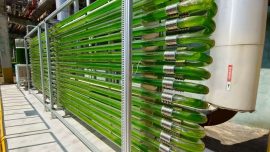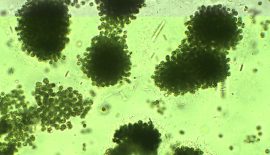ESAW培养液培养,文件资料来源于botany.ubc.ca
The medium given below can be made with either artificial seawater or natural seawater.
Artificial Seawater
Make two separate solutions: Solution I and Solution II. Add salts in order to distilled
deionized water (DDW). When the salts in each are completely dissolved mix
solutions together. Dilute to total volume with DDW.
| Solution I: Anhydrous salts |
Molecular Weight (g/mol) |
Amount to weigh: (g/l solution) |
Concentration (mM) |
| NaCl | 58.44 | 20.756 | 362.7 |
| Na2SO4 | 142.04 | 3.477 | 25.0 |
| KCl | 74.56 | 0.587 | 8.03 |
| NaHCO3 | 84 | 0.17 | 2.067 |
| KBr | 119.01 | 0.0845 | 0.725 |
| H3BO3 | 61.83 | 0.022 | 0.372 |
| NaF | 41.99 | 0.0027 | 0.0657 |
| Solution II – Hydrated salts | |||
| MgCl2 . 6H2O | 203.33 | 9.395 | 47.18 |
| CaCl2 . 2H2O | 147.03 | 1.316 | 9.134 |
| SrCl2 . 6H2O | 266.64 | 0.0214 | 0.082 |
| Enrichment Stocks | Stock Conc.(g/L) | Final Conc.(µM) | |
| 1 | NaNO3 | 46.67 | 549.1 |
| 2 * | Na2glycerophosphate | 6.67 | 21.8 |
| 3 | Na2SiO3 . 9H2O | 15.00 | 105.6 |
| 4 ** | Na2EDTA . 2H2O | 3.64 | 9.81 |
| *** | Fe(NH4)2(SO4)2 . 6H2O | 2.34 | 5.97 |
| FeCl3 . 6H2O | 0.16 | 0.592 | |
| 5 | MnSO4 . 4H2O | 0.54 | 2.42 |
| ZnSO4 . 7H2O | 0.073 | 0.254 | |
| CoSO4 . 7H2O | 0.016 | 0.0569 | |
| Na2MoO4 . 2H4O | 0.126 | 0.520 | |
| ** Na2EDTA . 2H2O | 1.89 | 5.05 | |
| 6 | H3BO3 | 3.80 | 61.46 |
| 7 | Na2SeO3 | 0.00173 | 0.001 |
Enrichment stocks can be refrigerated. Adjust Solution #5 to pH 6 using solid NaCO3 (about 2 g). Solution # 4 can be heated to dissolve the iron.
Notes:
* Can be replaced with an equimolar stock of Na2HPO4
** Add before the trace metals.
*** Can be replaced with an equimolar stock of FeCl3
| Vitamin Stock | Stock Conc.(g/L) | Final Conc.(mM) |
| Thiamine | 0.1 | 2.97 x 10-1 |
| Vitamin B12 | 0.002 | 1.47 x 10-3 |
| Biotin | 0.001 | 4.09 x 10-3 |
Vitamin stocks should be stored frozen.
TO MAKE 1 LITRE OF HESNW
1) Filter natural seawater through 0.45 µm membrane filter with a glass fiber prefilter.
2) Use a flask that has been acid-washed in 10% HCl and rinsed in distilled water before first use.
3) Pour 1 L filtered seawater or artificial seawater into flask. Add the following while mixing with a stir-bar:
a) 6 ml Combined Stock (Enrichment stocks #1,2,4-7)
(OR 1 ml of each individual stock solution)
b) 2 ml Silica Stock (Enrichment stock #3)
c) 2 ml Vitamin Stock
4) To reduce precipitation during autoclaving add:
d) 1.44 ml of 1N HCl
e) 0.12 g Sodium bicarbonate
5) Autoclave 20 minutes for one litre, ~ 30 minutes for 2 litres. Autoclaving for longer periods will result in more precipitation. Flasks should not be filled up more than 2/3 of their capacity, to avoid boiling over during sterilization.
6) Let stand for 2 days to allow pH to equilibrate (should be ~ pH 8.2).
7) Filter aseptically through a glass fiber filter to remove precipitate. Some taxa appear to be sensitive to it (optional).
Reference
Harrison, P.J., R.E. Waters and F.J.R. Taylor. 1980. A broad spectrum artificial medium for coastal and open ocean phytoplankton. J. Phycol. 16:28-35.



